Etruscan Pottery › Etruscan Religion › Etruscan Warfare » Origins and History
Articles and Definitions › Contents
- Etruscan Pottery › Ancient History
- Etruscan Religion › Ancient History
- Etruscan Warfare › Ancient History
Ancient civilizations › Historical places, and their characters
Etruscan Pottery › Ancient History
Definition and Origins
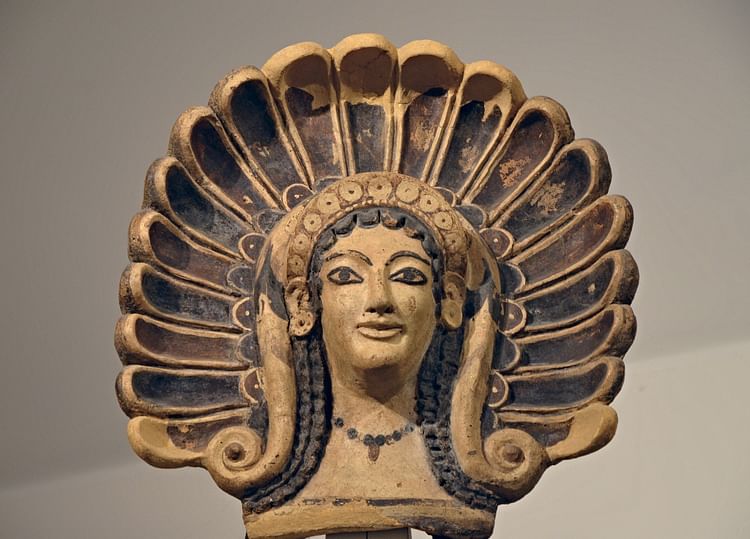
Etruscan pottery, produced over five centuries, was nothing if not varied. Indigenous wares such as the glossy black bucchero were made alongside red- and black-figure pottery imitating, yet modifying those produced in the Greek world.Geometric, floral, figure, and narrative decorations were appreciated and adapted from the Near East and Ionia, with even foreign potters and artists themselves settling in the cities of Etruria, such was the demand from the Etruscans for fine pottery for everyday use, at special banquets, and as offerings to their gods and dead. Pottery was also the material of choice for figure sculpture, best seen on the lids of large funerary urns, and as decoration for buildings in the form of statues and decorative plaques. Besides what they have left us of their own work, the Etruscans, great collectors of fine pottery that they were, have secured for posterity some of the finest Greek vases ever made and which now star in the collections of museums worldwide.
VILLANOVAN POTTERY
The Villanovan culture was a precursor to the more developed Etruscan civilization during the Iron Age in central Italy from c. 1000 to c. 750 BCE. In this period pottery was made by hand, not on the wheel, and used clay containing impurities of mica or stone which was fired at a low temperature producing relatively primitive wares. This type of pottery, known as impasto, was used to make bowls, storage jars, cooking pots, cups, and braziers. By the end of the 8th century BCE, potters had managed to improve the quality of impasto through long practice and refinement of technique.
Villanovan cemeteries contain burials of cremated remains in urns which are biconical (two vases with one smaller one acting as a lid for the other) and often carry simple incised decoration of geometric patterns, whirls, and swastikas, or even simple human 'stick' figures. Some urns have metal strips applied as decoration using lead or tin. One rarer type of urn, instead of a ceramic lid, has a bronze helmet on top with an impressive angular crest and embossed decoration.

Etruscan Model House
Another common form where terracotta was used was the production of small models of houses, made to contain the ashes of the deceased. Perhaps imitating real architecture, these have decoration on the exterior walls of geometric patterns and an aperture above the door for releasing smoke. They also have roof decorations, probably imitating the terracotta additions which became so typical in later Etruscan architecture.
RED ON WHITE WARES
This type of pottery, originating from Phoenicia, was produced in Etruria from the end of the 8th century BCE and into the 7th century BCE, particularly at Cerveteri and Veii. The red-coloured vessels were often covered with a white slip and then decorated with red geometric or floral designs. Alternatively, white was used to create designs on the unpainted red background. Large storage vases with small handled lids are common of this type and then kraters which also have scenes such as sea battles and marching warriors.
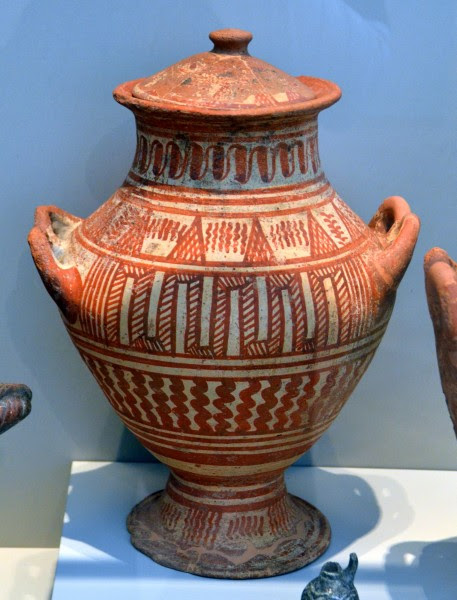
Etruscan Red on White Pottery Vessel
BUCCHERO WARES
Largely replacing impasto wares from the 7th century BCE, bucchero was used for everyday purposes and as funerary and votive objects. It was preceded by an intermediary type known as buccheroid impasto. Turned on the wheel, this new type of pottery had a more even firing and, using the process of oxidation in the kiln, gave a consistent and distinctive glossy dark grey to black finish (the clay's red ferric oxide being turned into black ferrous oxide).
THE ETRUSCANS WERE MEDITERRANEAN-WIDE TRADERS & THEIR POTTERY WAS THUS EXPORTED BEYOND ITALY TO PLACES FAR AFIELD AS IBERIA, THE LEVANT & THE BLACK SEA AREA.
The earliest known examples come from Cerveteri and date to c. 675 BCE. Bucchero was produced in many Etruscancentres (notably Cerveteri, Tarquinia, Veii, and Vulci ) and has become a hallmark of Etruscan presence at archaeological sites in central and northern Italy. The Etruscans were Mediterranean-wide traders, too, and bucchero was thus exported beyond Italy to places far afield as Iberia, the Levant, and the Black Sea area.
Common shapes include bowls, single- and two-handled cups, amphorae, chalices, and jugs. More elaborate pieces have the addition of three-dimensional figures of both humans and animals. Bucchero votive and funerary offerings typically take the form of figurines and service trays ( focolare ) complete with bowls, plates, cups, and utensils. Decoration resembles that of metal vessels with added pieces and carving before firing to resemble embossed work. Some bucchero vases were covered in gold or silver leaf, sometimes also a thin layer of tin. Vessels are most often plain but can be decorated with simple lines, spirals, and dotted fans incised onto the surface. Red ochre was sometimes painted into these incisions. Patterns and simply rendered scenes from mythology could be applied to the pot before firing using a stamp.
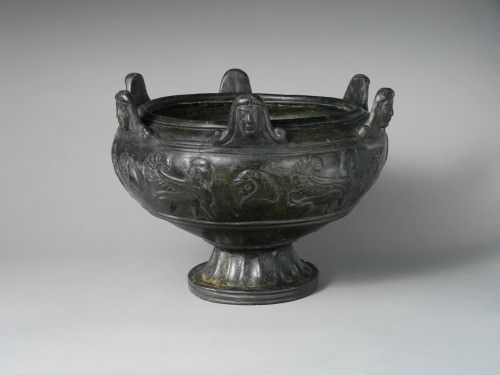
Bucchero Krater
Curiously, bucchero wares display the reverse trend of refinement seen in many other pottery type evolutions. The early period wares are finer with much thinner walls and more carefully made; these are known as sottile or fine (675-626 BCE). There is then an intermediary stage known as transizionale or transitional (625-575 BCE) before a final phase when wares are described as pesante or heavy (575-480 BCE). Finer wares are generally associated with the southern Etruscan cities and the heavier type with the northern. By the early 5th century BCE, bucchero was replaced by finer Etruscan pottery such as black- and red-figure wares.
ETRUSCO-GREEK WARES
Between 670 and 600 BCE, many pottery vessels were imported from Corinth especially, Attica, Ionia, and the Near East.Popular imports from Phoenicia were the beak-spouted jug and the 'pilgrim flask,' a round flat bottle with geometric decoration.These imported goods, and sometimes the immigration of the artists themselves, inspired Etruscan artists to produce their own versions and to copy the new style of decoration in their own work. Plants, animal and human figures now replaced the rather austere geometric designs that had hitherto dominated. Wares were produced in such large quantities that art historians have been able to identify several distinct Etruscan pottery painters based on style and subjects. One such artist is the Micali Painter of Vulci who is credited with over 200 surviving vases. Scenes from Greek mythology are typical but with local additions and inventions. The large Caeretan hydria, a two-handled vase for holding water, was a speciality of Cerveteri.
In the 4th and 3rd century BCE there developed a trend of using column -krater vessels as funerary urns and these were often painted with two large heads facing each other, one male and one female. Although not portraits as such, they are more natural than similar depictions on Greek pottery. An inventive method to cheaply imitate metal wares was developed whereby pottery vessels were dipped into a basin of tin to give them a thin shiny coating which resembled silver, hence their name, ceramica argentata. Finally, and unique to the Faliscan region, mould-made standing heads of a goddess (perhaps Demeter ) were manufactured and deposited as guardians in tombs.
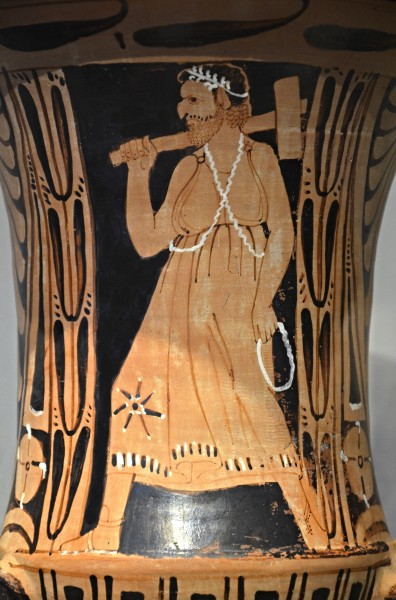
Etruscan Red-Figure Krater with Charun
Despite this varied home production, though, original Greek vases continued to be highly esteemed and frequently deposited in Etruscan tombs, one of the best sources of these wares outside Greece. As an example, the appropriately named Tomb of the Grecian Vases at Cerveteri had over 150 red- and black-figure pottery vessels from Attica deposited inside over several generations from 550 BCE onwards.
TERRACOTTA ROOF DECORATIONS
One unusual field of pottery which became a particular Etruscan speciality was the creation of terracotta roof decorations. The idea went back to the Villanovan culture where the apex roofs of simple huts received such decoration. The Etruscans went one step further than similar decorations on Greek buildings and produced life-size figure sculpture to decorate the roofs of their temples. Private buildings also had terracotta decoration in the form of plants, palms, and figurines. The most impressive survivor from this field is the striding figure of Apollo from the c. 510 BCE Portonaccio Temple at Veii. The interior of this temple was further decorated with terracotta panels depicting scenes from mythology.
Terracotta panels were also used on the outside of buildings, too, usually on gable ends, and the format is best seen in 7th- and 6th-century BCE examples from Acquarossa. They show scenes of a dinner or drinking party with guests lounging on benches; musicians and dancers, including one acrobatically doing a cartwheel; and a procession of warriors carrying spears and shields accompanied by charioteers. The panels are currently on display in the National Etruscan Museum at Viterbo.
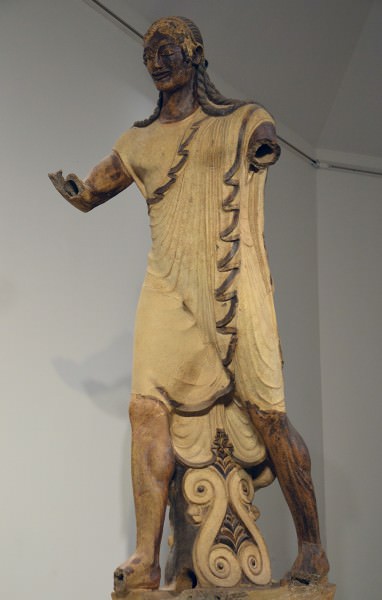
Apollo of Veii
SARCOPHAGI & FUNERARY URNS
The Etruscans buried the cremated remains of the dead in funerary urns made of terracotta. During the 6th century BCE, there was also a trend of burying the body in decorative sarcophagi. Both types could feature a sculpted figure of the deceased on the lid and, in the case of sarcophagi, sometimes a couple. The most famous example of this latter type is the Sarcophagus of the Married Couple from Cerveteri, now in the Villa Giulia in Rome. The two figures recline on a couch or bed with the husband's right arm around the shoulders of his wife. Originally they would have held objects such as perfume bottles or eggs, symbols of regeneration.
Chiusi offers another interesting use of pottery. Early tombs there contained large terracotta vessels inside which were placed 'Canopic' jars containing the cremated remains of the deceased. The jars, typically half a metre in height, are made to resemble human figures, sometimes with a bronze mask attached, dressed in clothing, belts, and jewellery, and seated on miniature thrones of stone, bronze, or terracotta.
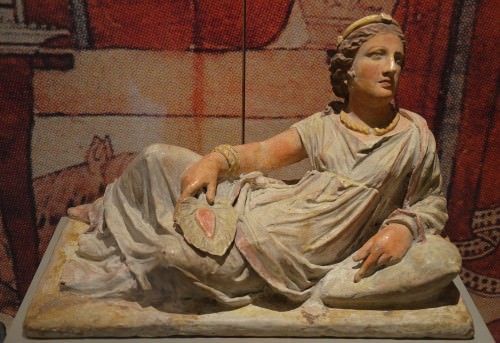
Etruscan Funerary Portrait
In the Hellenistic Period the funerary arts really took off, and figures, although rendered in similar poses to the 6th-century BCE sarcophagi versions, become less idealised and more realistic portrayals of the dead. They usually portray only one individual and were originally painted in bright colours. The sides of the lower box part are often decorated with relief sculpture depicting scenes from mythology or architectural motifs, for example, triglyphs and rosettes. The Sarcophagus of Seianti Thanunia Tlesnasa from Chiusi is an excellent example and is now in the British Museum in London.
Etruscan Religion › Ancient History
Definition and Origins
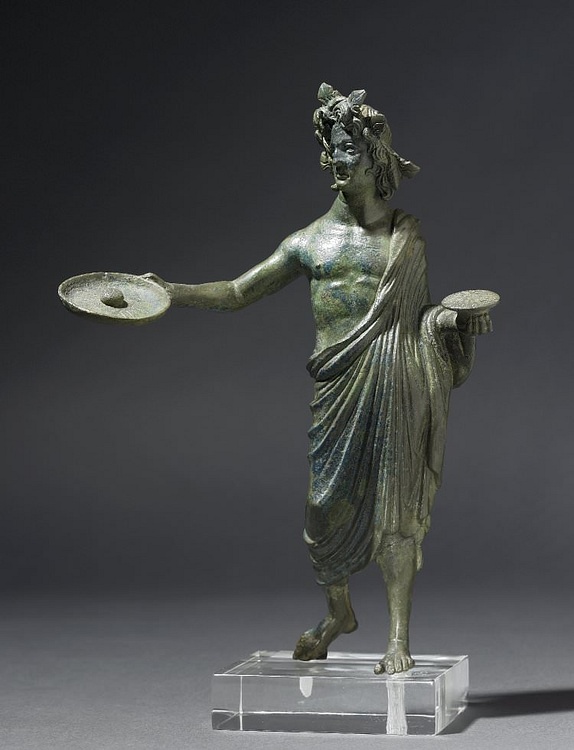
The religion of the Etruscans, the civilization which flourished from the 8th to 3rd century BCE in central Italy, has, like many other features of the culture, long been overshadowed by that of its Greek contemporaries and Roman conquerors. The polytheistic Etruscans had their own unique and distinct pantheon and practices, chief amongst which were augury (reading omens from birds and lightning strikes) and haruspicy (examining the entrails of sacrificed animals to divine future events).That the Etruscans were particularly pious and preoccupied with destiny, fate, and how to affect it positively was noted by ancient authors such as Livy, who described them as 'a nation devoted beyond all others to religious rites' (Haynes, 268).Etruscan religion would go on to influence the Romans, who readily adopted many Etruscan figures and rituals, especially those concerned with divination.
PROBLEMS OF INTERPRETATION
The Etruscan gods have long been seen by some as mere equivalents of their Greek and Roman counterparts, starting with Latin writers such as Cicero and Seneca, and while there may be some similarities in certain deities across the three cultures, it is not always the case. One of the problems for historians of Etruscan religion is that Roman writers are one of the chief sources of information from antiquity, and although they often quoted from now lost texts, their labelling and descriptions are not always accurate. In addition, Roman writers are sometimes biased in their descriptions, anxious as they were to minimise the contribution of the Etruscans to Roman culture. Additional sources which help redress this imbalance include inscriptions - especially on sarcophagi, votive offerings and bronze mirrors, and pictorial evidence such as tomb wall paintings and funerary sculpture made by the Etruscans themselves. Given these difficulties and the general lack of longer written texts on the subject, any summary of the Etruscan religion must, for the moment, remain incomplete.
ETRUSCAN GODS
As with many other ancient cultures, the Etruscans had gods for those important places, objects, ideas, and events which were thought to affect or control everyday life. At the head of the Pantheon was Tin (aka Tinia or Tina); Aita the god of the Underworld, Calu was god of Death, Fufluns of wine, Nortai of destiny, Selvans god of fields, Thanur the goddess of birth, Tivr (aka Tiur) was the goddess of the Moon, Usil the Sun god, and Uni was perhaps the queen of the gods and most important goddess. The national Etruscan god seems to have been Veltha (aka Veltune or Voltumna) who was closely associated with vegetation.
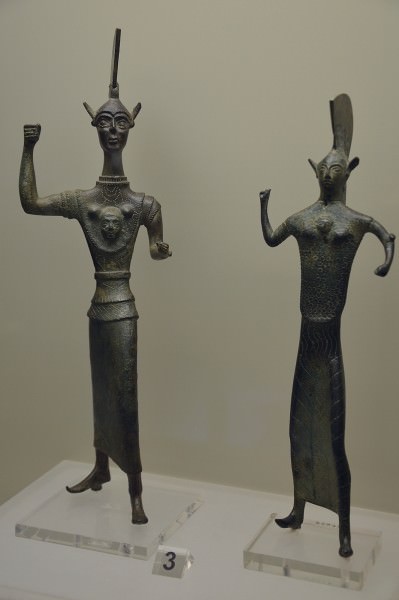
Etruscan Votive Statuettes of Menerva (Athena)
Lesser divine figures include the 12 advisors to the gods, the dii consentes, who had a reputation of acting without mercy;young female figures similar to the Greek nymphs known as Lasa; winged females known as Vanth who seem to be messengers of death; and various heroes, notably Hercules and the Tinas Cliniar (twin sons of Tin and equivalent to the Greek Dioscuri ). One figure who, perhaps not surprisingly, appears frequently in Etruscan tomb wall paintings is Charu (or Charun) who, unlike the Greek version of the ferryman who transports souls to to the Underworld, has a hammer and key, presumably in his role as gatekeeper to the next world (hammers were used to move the heavy bar of city gates).
By the 5th century BCE, many Etruscan gods became assimilated to Greek ones, a process seen in art objects (eg black-figure pottery and mirrors) where images of the Olympian gods are given Etruscan names in added inscriptions. Thus Zeus is Tin, Uni is Hera, Aita Hades, Turan is Aphrodite, Fufluns Dionysos, and so on. It also seems that earlier Etruscan gods were somewhat faceless deities while the Greek influence increased their 'humanisation,' at least in art.

Etruscan Red-Figure Krater with Charun
PRIESTS & THE ETRUSCA DISCIPLINA
Priests ( cepen ) consulted the collection of sacred texts known as the Etrusca disciplina. This corpus of literature is now lost (perhaps deliberately so by early Christians), but it is described and referred to by Roman writers. The three main sections detail the reading of omens (for example, the flights of birds and lightning strikes), the prediction of future events by consulting animal entrails following their sacrifice (the liver being an especially valued object of examination), and general rituals to be observed so as to gain favour from the gods. Other matters covered include instructions for founding a new settlement, procedures for placing city gates, temples and altars, and guidance for farmers. The Etruscans believed that all this wealth of information came from a divine source, two in fact: the wise infant Tages and grandson of Tin, who miraculously appeared from a field in Tarquinia while it was being ploughed, and the nymph Vegoia (Vecui). These two figures revealed to the early Etruscan leaders the proper religious procedures expected by the gods and the handy tricks of divination.
PRIESTS HAD IMPORTANT ROLES IN GOVERNMENT AS THERE WAS NO SEPARATION OF RELIGION FROM THE STATE, OR FROM ANY OTHER BRANCH OF THE HUMAN CONDITION.
Priests were predominantly males, but there is limited evidence that some women may have had a role in ceremonies. They learnt their subject in university-type institutions of training with that at Tarquinia being particularly renowned. Priests would also have had important roles in government as there was no separation of religion from the state, or from any other branch of the human condition either, for that matter. In this context, the mention in inscriptions that sometimes priests were elected is more understandable.
Augurs, the readers of signs, were identified by the staff with a coiled top which they carried, the lituus, and their dress: a long robe, sheepskin jacket, and conical peaked hat. Priests are depicted as clean-shaven while trainees are not. Their knowledge of reading entrails was a deep one as a bronze votive liver from Piacenza illustrates. The piece is divided into an incredible 40 sections and inscribed with 28 gods, indicating the complexity of the subject and exactly which god was likely in need of offerings depending where any imperfection of the liver might occur. Those priests who interpreted birds' flight or thunder and lightning had to possess a similar mind map as just which part of the sky these phenomena occurred in, the direction, the type of thunder, lightning or bird (owls and crows croaking were especially inauspicious), and the time and date would all indicate which of the thunder and sky gods was angry or pleased that day.
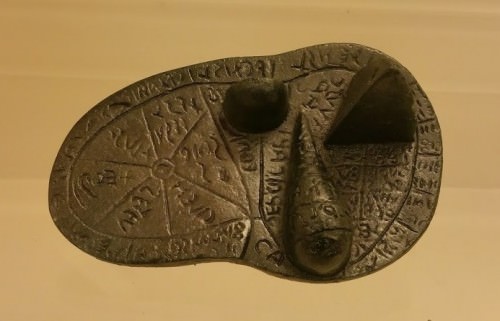
Etruscan Model Liver For Divination
The Etruscan preoccupation with knowing the future was not because they thought they could influence it for they believed that everything is already predetermined. This abandonment of humanity's possibility to affect future events distinguishes it from contemporary religions such as the Greek. At best, terrible events could only be identified and postponed, perhaps diminished a little in severity, or even directed towards others, but they could not be avoided.
RELIGIOUS PRACTICES
The focus of Etruscan religious ceremonies was animal sacrifices, which took two forms. The first was to burn the offering in honour of the gods who dwelt in the heavens, while the second form was to honour underworld deities by offering the blood of the animal sacrificed. This was done by allowing it to drain into a special conduit which ran into the ground beside the altar.Similar libations were made in tombs when burials were made. The sacred precinct was also the scene of food offerings, prayers and hymn singing to a musical accompaniment.
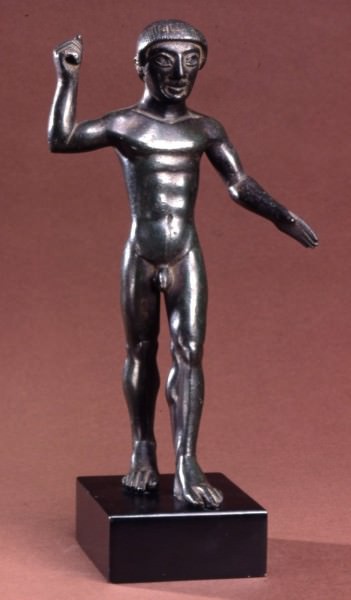
Etruscan Bronze Youth
Votive offerings were made by all classes and both sexes as inscriptions on them by the offerer attest. These could take the form of small terracotta figurines of animals and humans (including individual body parts), vases, bronze statuettes, and anything else the offerer considered valuable enough to win the gods' favour. Offerings were left not only at temples but also at natural spots considered sacred such as rivers, springs, caves, and mountains. Offerings were left in tombs, too, to help the deceased in the next life and ensure the gods looked favourably on them.
Another method to attract the favour of the gods and avoid personal calamities was to wear amulets or charms, especially for children. The most common, the bullae, were small lentil-shaped capsules worn on a string around the neck. Similarly, one could do the opposite and inflict harm on others by preparing curse tablets or tiny figurines with their hands tied behind their backs which were sometimes thrown into wells.
ETRUSCAN TEMPLES
The earliest Etruscan sacred spaces had no architecture to speak of, merely being an outdoor area defined as sacred with an altar where rites were performed. Some areas had a rectangular podium from where omens could be observed. Over time, buildings, probably only of wood and thatch at first, were erected and the first Etruscan stone temple appears at Veii c. 600 BCE.
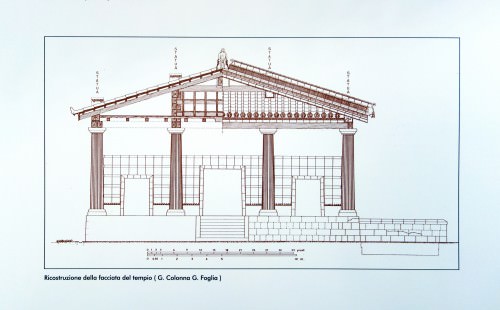
Etruscan Temple Reconstruction
Etruscan temple architecture has been difficult to reconstruct because of the lack of surviving examples. The Roman architect and writer Vitruvius describes a distinct 'Tuscan temple' type with a columned portico and three small chambers at the rear interior, but evidence points to a more varied reality. One of the best documented Etruscan temples is the c. 510 BCE Portonaccio Temple at Veii. With a front stepped-entrance, columned veranda, side entrance, and three-part cella, it does match Vitruvius' description. The roof was decorated with life-size figure sculpture made in terracotta, a figure of a striding Apollo survives. The temple was perhaps dedicated to Menrva (the Etruscan version of Athena / Minerva ). As in Greek temples, the actual altar and place of religious ceremonies remained outside the temple itself.
All towns had sacred precincts and usually three temples, considered the most auspicious number. Some sanctuaries attracted pilgrims from across Etruria, even from abroad and the most famous were the large Temple at Pyrgi near Cerveteriand the Fanum Voltumnae sanctuary, possibly near Orvieto (exact location as yet unknown). At the latter elders of the various Etruscan cities met annually for the most important religious festival in the Etruscan calendar.
ETRUSCAN BURIAL PRACTICES
The burial practices of the Etruscans were by no means uniform across Etruria or even over time. A general preference for cremation eventually gave way to inhumation, but some sites were slower to change. Simpler stone cavities with a jar of the deceased's ashes (which at Chiusi have lids carved as figures) and a few daily objects gave way to larger stone tombs enclosed in tumuli or, even later, free-standing buildings often set in orderly rows. These latter 7th-5th-century tumuli and block tombs had more impressive goods buried with the uncremated remains of the dead (one or two persons) such as jewellery, dinner service sets, and even chariots. The presence of these objects is an indicator of the Etruscan belief in the afterlife which they considered a continuation of the person's life in this world, much like the ancient Egyptians. There is no evidence the Etruscans believed in any sort of punishment in the afterlife, and if art is to be considered, then it would seem that the hereafter was, starting with a family reunion, an endless round of pleasant banquets, games, dancing, and music.
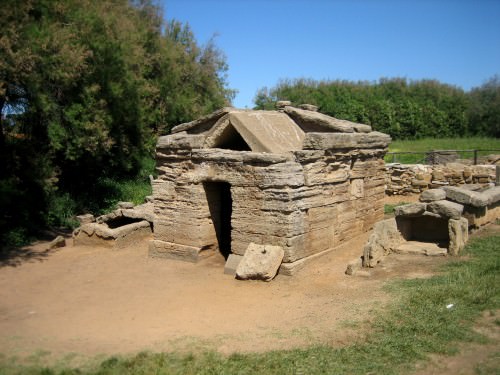
Etruscan Tomb at Populonia
The walls of the tombs of the elite were painted with colourful and lively scenes from mythology, religious practices and Etruscan daily life, especially banquets and dancing. The 4th-century BCE Francois Tomb at Vulci is often cited as the finest example. Ornate sarcophagi become more common from the 4th century BCE, while in the Hellenistic period cremations return alongside inhumations, this time in terracotta boxes with a large painted figure sculpture on the lid depicting the departed. Many tombs of this period were in use for several generations.
INFLUENCE ON THE ROMANS
The Etruscans were not the first civilization which endeavoured to interpret signs in entrails and celestial phenomena or create calendars of significant events, as the ancient Babylonians and Hittites were noted for their expertise in this field before them.Nor would the Etruscans be the last, as the Romans adopted the practice too, along with other features of Etruscan religion such as rituals for establishing new towns and dividing territories, something they would receive ample practice opportunities for as they expanded their empire. The Romans were keen to suppress any idea that they were culturally influenced by the Etruscans, but religion is one area where they acknowledged their debt more readily. Soothsayers and diviners became a staple member of elite households, rulers' entourages, and even army units, and if that learned individual was an Etruscan or of Etruscan descent, the acknowledged experts in such matters in the Mediterranean, then so much the better.
Etruscan Warfare › Ancient History
Definition and Origins
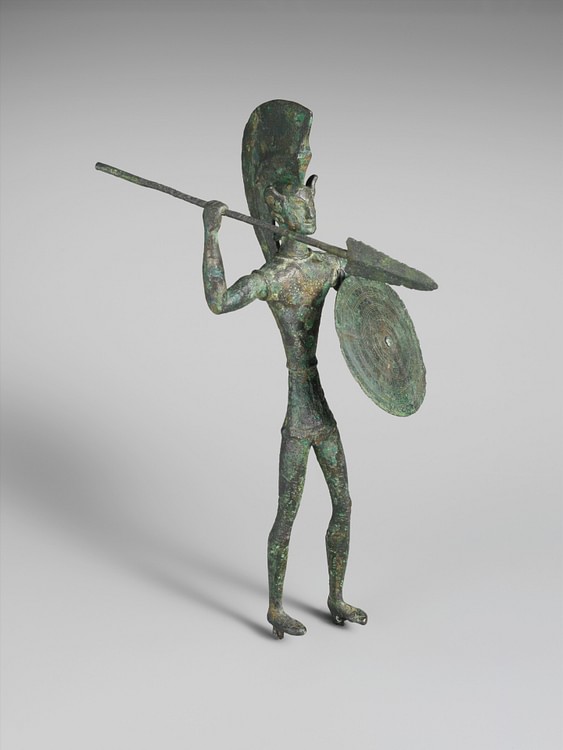
The Etruscan civilization, which flourished in central Italy from the 8th to 3rd century BCE, gained a reputation in antiquity for being party-loving pushovers when it came to warfare, but the reality is somewhat different. History being most often written by the victors, the Etruscans were conquered by and assimilated into the Romans' fast-growing empire, and Latin authors minimised the debt they owed to Italy's first great civilization and the difficulties they had in establishing themselves as top dog in the region. Without extensive written texts of their own, the history of the Etruscans must be pieced together from what little remains of their culture, namely, the ruins of fortification walls, surviving weapons, armour, and artworks depicting warfare-related themes, and secondhand accounts of ancient writers. Nevertheless, some features of Etruscan warfarebecome clear: the use of bronze armour, shields and swords, a preoccupation for defence shown in the building of fortification walls, and a general lack of unity between cities, which would, in the end, ring the death knell of the Etruscan culture.
WEAPONS & ARMOUR
Etruscan armies, like most Mediterranean fighting powers of the day, were drawn from the citizen body who were otherwise farmers when not at war. Soldiers paid for their own equipment and fought for their individual city-state to protect its and their own interests either to defend their territory or expand it, for control of trade routes on land and sea, and to acquire the resources they deemed necessary. From the 5th century BCE, evidence of paid soldiers and mercenaries is seen in the minting of coinage for that purpose.
CORINTHIAN HELMETS HAVE BEEN FOUND IN ETRUSCAN TOMBS, BUT THE MOST COMMON TYPE IS THE PLAIN BELL-SHAPE IN BRONZE WHICH HAS A NARROW BRIM.
Armour was of bronze and took the form of breastplates, greaves to protect the lower legs, helmet, and round shield, much like the hoplite of Greek warfare. It is likely that hardened leather was widely used as body armour too. Lighter and more effective than bronze, such perishable material would not have survived as bronze armour has done. The principal weapons were bronze spears and double-edged swords. A stele from Vetulonia depicts an Etruscan warrior carrying a double-axe, but this may have been a symbol of authority rather than a weapon. Both bronze armour and weapons of the Greek hoplite type have been found in multiple Etruscan tombs of the 8th and 7th century BCE at sites such as Cerveteri, Tarquinia, Veii, and Vetulonia. However, it is important to note here that some of these weapons, and helmets in particular, may have only had a symbolic ritual purpose and may not have actually been used in battle. An example is the famous bronze helmet of Veii with its huge and impractical bronze triangular crest. Corinthian helmets have also been found in tombs, but the most common type is the plain bell-shape in bronze which has a narrow brim and, in some cases, detachable cheek-guards.
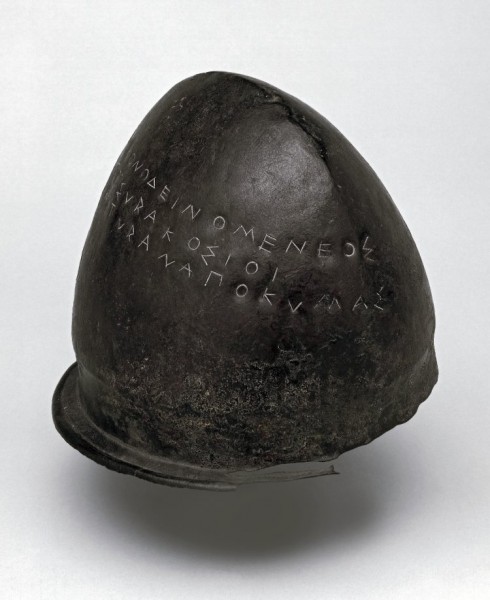
Etruscan Bronze Helmet
Another less than clear issue is the Etruscan use of horses in warfare. Tombs abound with bronze horse bits, and there are numerous bronze two-wheeled chariots interred with the dead. Just whether these were used in warfare or if they were merely a symbol of wealth or whether they were intended only to aid the deceased in their passage into the next life is a moot question.
ORGANISATION & TACTICS
As the historian N. Spivey makes clear, reconstructing the Etruscan military past has its difficulties:
The literary evidence is untrustworthy, and the iconographical evidence is to be treated with caution.Constructing Etruscan realities from depictions of warriors on either imported Greek and near-eastern artefacts is dangerous. (127)
Roman writers and Etruscan art demonstrate that Etruscan warriors, armed as they were like the hoplites of Greece, may also have adopted the Greek phalanx formation – a line of warriors moving forward as one on the battlefield with spears bristling and protecting each other with a solid barrier of bronze shields. Hoplite warfare was brief and brutal with the two sides clashing but had the advantage that the issue was often settled in one encounter.
SUCH TACTICS AS THE PHALANX MAY ONLY HAVE BEEN USED EARLY ON IN ETRUSCAN HISTORY WHEN BATTLES WERE BETWEEN RIVAL CITIES TO SETTLE DISPUTES IN A FORMULAIC SET-PIECE BATTLE.
However, such tactics as the phalanx may only have been used early on in Etruscan history when battles were between rival cities to settle disputes in a formulaic set-piece battle. The fact that most Etruscan helmets are of a simpler bronze bowl type would suggest that warfare was typically more dynamic, and greater visibility and mobility required that type of helmet. The greater protection but more restricted visibility of the Corinthian helmet is better suited to more static phalanx engagements, but they are in a minority when it comes to archaeological finds. Similarly, shields are generally smaller in the 5th century BCE as compared to the 6th century BCE.
FORTIFICATIONS & SEIGE WARFARE
Many Etruscan cities were protected by city walls. Not always entirely enclosing a city, they protected it from attack at its weakest points. Those sections not benefitting from a wall were usually protected by a natural precipice or man-made terraces and ditches. Portions of fortification walls survive at Cerveteri, Tarquinia, Veii, Vulci, and other cities. Made from either mud-bricks on top of stone plinths or entirely from tufa blocks, most date from the 5th century BCE. Many include well-built gates with their own towers. Such fortifications were designed to offer the community – both town and country dwellers – a temporary point of refuge in the case of attack. However, that walls could stand a prolonged attack is evidenced by the 10-year Roman siege of Veii between 406 and 396 BCE.
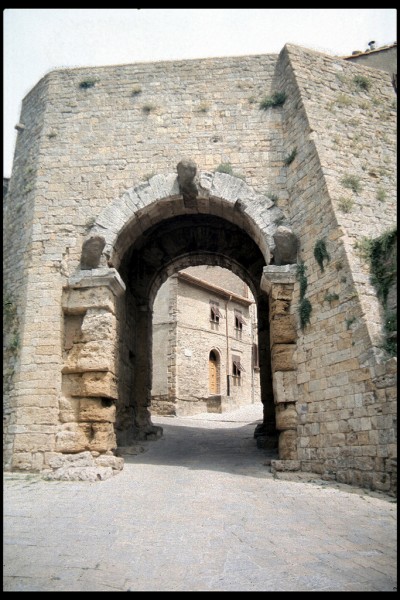
Porta all' Arco, Volterra
NAVAL WARFARE
If the history of Etruscan land warfare is rather patchy, then their naval exploits are positively threadbare in the historical record. With a plentiful supply of timber, the Etruscans were able to build large sailing ships which, under the power of oars in battle, could ram enemy ships to be then boarded by their compliment of foot soldiers if necessary. The importance to the Etruscan economy of maritime trade is attested by the depiction of ships in art, the presence of model ships in tombs, and the prodigious amount of foreign goods that found their way to Etruria.
That the Etruscans were able sailors and navigators is attested by Greek and Roman writers, even if only by the rather backhanded compliment of continuously referring to them collectively as Tyrrhenian pirates, such was their domination of the waters off the coast of western Italy. This ' piracy ' was more likely legitimate trade operations which the Greeks and Romans would dearly have loved for themselves. The legendary prowess of Etruscan seamen is further illustrated in the Greek myth that even the god Dionysos found himself captured by them and only managed to escape by changing the sailors into dolphins. Greek writers mention that the Etruscans managed to occupy parts of Sicily, Sardinia, Corsica, Samos, and southern France and Spain, even rivalling the great naval power of Carthage in the Mediterranean. The good times at sea came to an end, though, with the rise of Syracuse and defeat at the Battle of Cumae in 474 BCE.
ROMAN CONQUEST
The Etruscan armies of part-time soldiers, probably recruited on a basis of kinship or clan membership, proved to be no match for the more professional and tactically dynamic Roman army which was able to draw on greater resources of both men and equipment. Another disadvantage of the Etruscan cities was their failure to support each other against the common threat of Rome. Individual cities had in the past formed alliances to good effect, as seen in the defeat of a Phocaean fleet by a joint Cerveterian and Carthaginian force in 540 BCE, but the military weakness of the Etruscans was all too evident in the wave of attacks from Syracuse in the first quarter of the 4th century BCE when Etruscan coastal sites were sacked and their lucrative trade routes taken over by the Sicilians.
Etruria, or more correctly, the northern parts of Italy the Etruscans had colonised, was also attacked from the north by migrating Celts starting from the beginning of the 5th century BCE, a conflict which culminated in defeat at the Battle of Melpum (Milan) in 396 BCE. After six centuries, the Etruscan control of central Italy was suddenly under serious threat from two directions.

Battle Scene, Francois Tomb, Vulci
The Etruscan cities had long been rivals and frequently fought each other if tomb paintings of local wars such as those of the Francois Tomb at Vulci are taken as typical. Additional evidence of infighting between Etruscan cities is found at such sites as Acquarossa which were abandoned and the population absorbed into larger neighbouring towns. Further, as Rome encroached into Etruria moving ever northwards, the Etruscan cities failed to mobilise the Etruscan League and transform that body from a religious to a military organisation of mutual aid. The Romans still did not have everything their own way, though.The legendary king of Chiusi Lars Porsenna had attacked Rome in the final decade of the 6th century BCE, and the Etruscans proved a stubborn foe to conquer.
Battles, sieges, and the sacking of cities would rumble on for two centuries in a brutal fight for control of central Italy. Tarquinia famously sacrificed 307 Roman prisoners in their forum in 356 BCE, which brought a retaliation murder of 358 Tarquinian prisoners in Rome. The Etruscans formed an alliance with the Samnites, Umbrians, and Gauls to face Rome, but despite some initial successes, the Romans won a decisive victory at Sentinum in 295 BCE, and sieges of towns such as Chiusi, Perugia, and Troilum soon followed. Another Roman victory came in 283 BCE at the Battle of Lake Vadimo against an Etruscan- Gaul alliance.
In 281-280 BCE, more Roman victories against the likes of Tarquinia, Orvieto, and Vulci meant that most of Etruria finally fell under Roman control; colonies of veterans were established, and once great Etruscan towns were reduced to minor Roman settlements. One of the last Etruscan towns to fall was Cerveteri in 273 BCE whose lands were confiscated and redistributed.Through a mix of diplomacy, alliances, prolonged truces, and military prowess, the Romans had established themselves as the masters of Italy, the first step in their quest to control the Mediterranean and beyond.
Sadly for the Etruscans, this was not the end of the fighting. Etruscan armies sided with Rome in the Battle of Talamone against the Gauls in 225 BCE, and although the former Etruscan cities made the wise decision to stay loyal to Rome whenHannibal invaded Italy during the Second Punic War (218-201 BCE), many northern towns then unwisely sided with Mariusin the Roman civil war of the early 1st century BCE. The victor of that conflict – Sulla – then took brutal revenge, mercilessly sacking such cities as Chiusi, Populonia, and Vetulonia in 83 and 82 BCE. The Etruscans were finished as a warring nation, and even their very culture was fast disappearing into the new reality of a Roman world.
LICENSE:
Article based on information obtained from these sources:with permission from the Website Ancient History Encyclopedia
Content is available under License Creative Commons: Attribution-NonCommercial-ShareAlike 3.0 Unported. CC-BY-NC-SA License